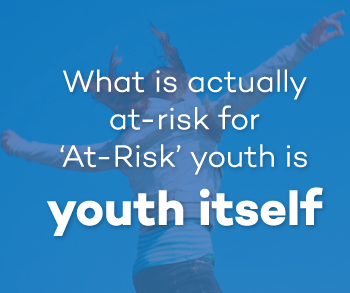I have been operating a regional youth service organization (The RAFT) for the last 8 years. The youth we serve are described as ‘At-Risk and Homeless’; which is a very broad category ranging from kids lacking after school programs to kids living rough on the street. In my eight years, no one has ever questioned me on this definition; most nod their heads knowingly. Some people envision kids living under bridges, while for others it speaks to histories of family trauma, drugs and alcohol abuse/misuse, sexual abuse, criminal behaviours, poverty and mental illness. This is by no means an exhaustive list and remains extremely subjective to the ideology and experience of the audience.
Due to this ambiguity we have developed and operated a number of different programs and projects to address these problems. However, in the end all of these different programs have the same result transitioning a youth to an adult: a youth who is now capable of living life on their own and preferably independent of social programs. How we do this varies greatly depending on the type and reliability of funding. In an underfunded hostel system lacking any outreach or supportive after care, this generally means a quick round of shock therapy and a sharp introduction to the ‘real world’, also known as ‘toughening them up’. In the end, those who actually succeed are the youth who have been able to develop the longest as a youth and so have gained the ability to make the necessary transition to adulthood.
The great value that all these programs provide, even the least well-funded, is a safe, respectful atmosphere that works to translate the adult world into a world that is comprehensible to young people. Once, early on in my employment in this field, a local funder asked me what they could provide in lieu of money. I half jokingly replied “day planners”. I say, “half jokingly” because I was amazed at the number of youth who set their progress back or even halt it, just by missing appointments. Sadly, another six years past before I really came to understand that there was more truth to my joke then I realized.
 Which leads me back to the definition of our youth as ‘At-Risk’. As I mentioned, this term is a catch-all for every conceivable deficiency we (adults) care to ascribe to young people. This is a bit like not seeing the forest for the trees. It occurs to me that what is actually at-risk for ‘At-Risk’ youth is youth itself. Whether we are toughening them up, providing steps to independent living or transitioning to independence the inference is clear: kids are forced to become adults now. Their life as a young person is over and society expects and demands a grown-up response no matter what their age or previous life experience.
Which leads me back to the definition of our youth as ‘At-Risk’. As I mentioned, this term is a catch-all for every conceivable deficiency we (adults) care to ascribe to young people. This is a bit like not seeing the forest for the trees. It occurs to me that what is actually at-risk for ‘At-Risk’ youth is youth itself. Whether we are toughening them up, providing steps to independent living or transitioning to independence the inference is clear: kids are forced to become adults now. Their life as a young person is over and society expects and demands a grown-up response no matter what their age or previous life experience.
I believe that this is the true tragedy for the youth who we serve. In a practical sense, this means that education ceases to be about learning and rather becomes an avenue to employment. It means an end to experimentation and the beginning of adult responsibility. It is the moment when a young person’s problems and struggles are no ones but their own. It is too late for some of our youth; regardless of age or experience they need to become adults to deal with their new reality. However, with a proper understanding of ‘At-Risk’ youth, we can design our programs to provide that space which allows young people to be youth and to stay youth. Effort needs to be put into prevention measures, into helping families stay connected and into keeping kids in school with programs that focus on youth development. If we can do this, we just might be able to save youth and to allow them to enjoy their adolescence for what it is – a period of time to adjust from the freedom of childhood to the responsibilities of adulthood.

